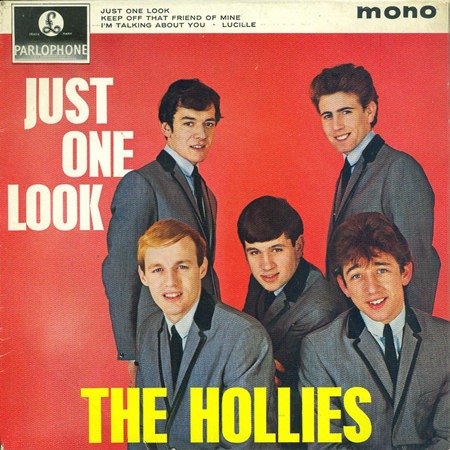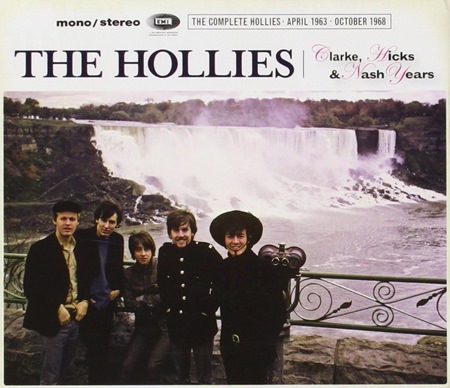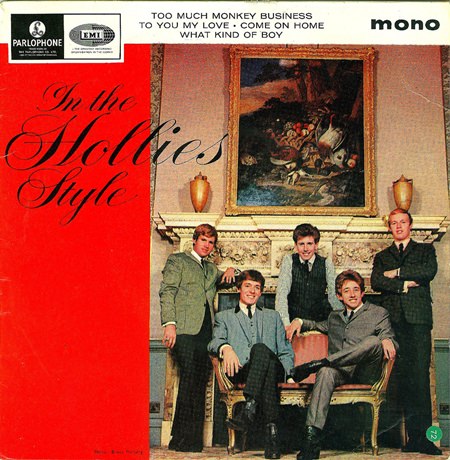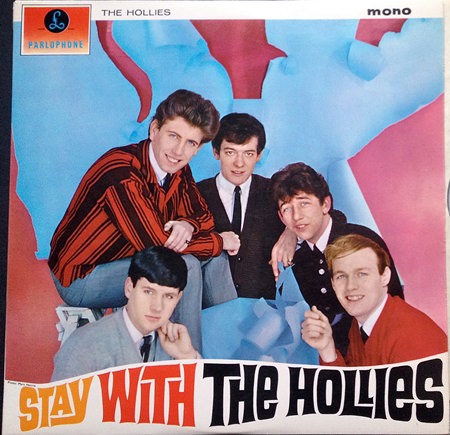Between April 1963 and May 1965, The Hollies released 7 singles, 5 EPs and 2 albums, and transformed themselves from a rickety novelty act with clumsy rhythm & blues-aspirations to a fully fledged and extremely powerful hit machine that would spearhead British pop music through the mid and late 60’s and even give The Beatles a run for their money.
Allan Clarke has retired and Graham Nash is doing his own stuff, as he’s been doing ever since he left The Hollies in 1968 for America and Crosby, Stills & Nash. But original members Tony Hicks and Bobby Elliot are still out there keeping The Hollies alive, doing the concert rounds, making people happy.
This then, is how it all began.
“(Ain’t That) Just Like Me” / “Hey What’s Wrong With Me” (Parlophone, R 5030) – Released: May 1963
You gotta start somewhere. The Hollies do it with a misjudged loan from The Coasters. The song’s novelty definitely had expired by 1963, and rhythm & blues for kids never caught on big anyway. The silly lyrics borrow stanzas from children’s songs like “Mary Had A Little Lamb”. The band seem so embarrassed with the words that they shoot out of the verses and dive into the propeller fast choruses with visible relief.
Guitars rattle, drums are pure 1963 and the guitar solo frantically tries to copy Chuck Berry. Who could have predicted that this band would end up as one of the biggest hit-makers in British pop music history? Anyway, this was how the pride of Manchester started out (Oasis eat your heart out!)
B-side “Hey What’s Wrong With Me” is Buddy Holly meets the fast walking bass of The Beatles’ “I Saw Her Standing There”, with their vocal harmonies of “Twist And Shout” thrown in for good measure.

“Searchin” / “Whole World Over” (Parlophone, R 5052) – Released: August 1963
In the early 60’s every British band had “Searchin ‘’ on their playlist. The Beatles performed it frequently in Hamburg. The raw rhythm & blues classic was written by legendary team Jerry Leiber & Mike Stoller for the humorous, but extremely talented The Coasters. Their version reached #3 in the US in 1957.
The Hollies’ version is adequate, but not very original. They play it tough enough, the rhythm a bit square wheeled, the call-response criss-crossing between lead vocal and backing singers quite exciting. But it still sounds very much like a cover and the attempt to copy the humour which is an important element in The Coasters’ original version, seems oppressively forced.
A lonely harmonica, Buddy Holly’s soft sobbing melancholia and the Everly Brothers’ vocal harmonies grace the workmanlike B-side, written by Allan Clarke and Graham Nash.
“Stay” / “Now’s The Time” (Parlophone, R 5077) – Released: November 1963
England was slowly recovering from the Liverpool onslaught when 1963 drew to a close. The wild, but orthodox rhythm & blues of The Rolling Stones and the jungle drumming of Dave Clark Five had put London back on the map. And even Manchester got to play with the big boys thanks to The Hollies establishing themselves in the hit parade with three releases, all of them medium sized hits, not a bad start even if none of them could be called classics.

One of the main reasons for the success was their three part harmonies, fully developed, extremely tight and powerful with a steely quality, voices sharp as a razorblades. When they cut through the speaker(s) there was no mercy. The Hollies sounded like a heavily armed mixture of Beatles and Everly Brothers. Their rickety instrumental work left something to be desired, but they got away with it. With voices like that there was no stopping them.
“Stay” was a good choice for the important third single. People still remembered Maurice Williams & The Zodiacs’ original, a #1 in the US in 1960, and a Top 20 hit in England the following year. The Hollies chose to rearrange it completely, sacrificing playful doo-wop soul for speed. It rattles along at a frantic pace, Graham Nash’ falsetto desperately trying not to be thrown off. I’ll give them credit for the enthusiasm.
Trivia: There’s an exquisite version of “Stay” on the Jackson Browne-album “Running On Empty” (1977).
B-side “Now’s The Time” is a slice of archetypical Merseybeat and moves along merrily with some nice harmony singing, but the tune itself is faceless. Written by Clarke and Nash.
Stay With The Hollies (LP) (Parlophone PMC 1220) – Released: January 1964
13 awful rhythm & blues covers, and one uneventful Clarke/Nash-original.
“Just One Look” / “Keep Off That Friend Of Mine” (Parlophone, R 5104) – Released: February 1964
A huge US hit for Doris Troy during the summer of 1963. The Hollies turn it into a winter ditty, fresh as peppermint. The rickety playing is Merseybeat at its most typical. But the harmony singing is outstanding. It elevates the recording and makes it shine. Captivating.

“Keep Off That Friend Of Mine” is beat group fodder, easy on the ear, nice vocal interplay between Clarke and Nash and an above average B-side. Written by Tony Hicks & Bobby Elliot, the latter no doubt is responsible for the rather tricky rhythm patterns.
“Here I Go Again” / “Baby That’s All” (Parlophone, R 5137) – Released: May 1964
A Merseybeat ballad with an overwhelming power-chorus. Sung partly as a Clarke/Nash duet partly as a three part harmony heaven. The vocal arrangement, the pushy drumming during the choruses, and that quirky closing chord – The Hollies had never copied The Beatles this blatantly before, and they would never do it again. A delightful record. Written by Mort Shuman and Clive Westlake.
The B-side is another showcase for the group’s wonderful harmony singing delivered on a bed of chiming guitars Searchers style. Written by Chester Mann.
The Hollies (EP) (Parlophone, GEP 8909) “Rockin’ Robin” / “What Kind Of Love” / “Whatcha Gonna Do ‘bout It” / “When I’m Not There” – Released: June 1964
Tracks 1 and 3 are both inferior cover versions and lifted from the Hollies’ first album “Stay With The Hollies”. Tracks 2 and 4, both written by Clarke/Nash/Hicks, are unique for this EP.
“What Kind Of Love” could have been an A-side in its own right and definitely should have been the EP’s lead off track. A fantastic and fully realised pop tune with loads of harmonic voices, Clarke’s steely lead and Graham’s tingeling falsetto, a strong melody that twists and turns, full of surprises. As good as anything they would do in 1966 and 1967.

“I’m Not There” isn’t bad either. Highly commercial, but maybe a little bit dated. It’s got 1963 fingerprints all over it, both the guitar work and the drumming. But the vocals are pure gold.
Just One Look (EP) (Parlophone, GEP 8911) “Just One Look” / “Keep Off That Friend Of Mine” / “I’m Talkin’ About You” / “Lucille” – Released: July 1964
Both sides of their “Just One Look”-single and then two tracks from “Stay With The Hollies”, proving that The Hollies were hopeless when they tried their luck with rhythm & blues and classic rock’n’roll material.
“We’re Through” / “Come On Back” (Parlophone, R 5178) – Released: September 1964
The Hollies’ first self written A-side, though Clarke/Hicks/Nash hide behind the alias ‘Ransford’. The melody isn’t that strong, but is saved by a clever arrangement. Kind of a bossa nova spiced with a reoccurring theme finger picked on acoustic guitar. Allan Clarke pulls the load in the soft-spoken verses while we get the full three part harmony treatment in the choruses, hitting the higher register like a welding flame. “We’re Through” is a mix of past, present and future. The band are not quite leaving their Merseybeat origins behind, but the song signals a bolder approach to arrangements – and proves that they are more than capable of writing their own hit hits. A memorable tune, reminiscent of the later Unit 4+2.
The B-side is another Ransford offering. A rollicking humdinger in the early Beatles’ neighbourhood, including frantic bass and blaring harmonica. The middle eight is a clever detour that saves the tune from sounding too dated.
Here I Go Again (EP) (Parlophone GEP 8915) “Here I Go Again” / “Baby That’s All” / “You Better Move On” / “Memphis” – Released: October 1964
Both sides of their “Here I Go Again”-single plus two tracks from “Stay With The Hollies” that yet again prove that The Hollies should have stayed out of Rolling Stones-territory. No way they could handle rhythm & blues with any conviction.
In The Hollies Style (LP) (Parlophone, PMC 1235) – Released: November 1964
Five poorly executed rhythm & blues-covers, plus 7 tracks credited to their alias Ransford. Clearly an improvement on their first album.
We’re Through (EP) (Parlophone, GEP 8927) “We’re Through” / “Come On Back” / “What Kind Of Boy” / “You’ll Be Mine” – Released: December 1964
The band’s fourth EP-release in a year. The Hollies used the format to re-sell their most recent single just as its lifespan had come to an end on the Top 30, and plug their most recent album by adding a couple of tracks from it. “What Kind Of Boy” is an adequate cover of Big Dee Irwin song, with a dragging beat and a strong Clarke vocal. “You’ll Be Mine” sounds like The Merseybeats, lightweight fodder from the Ransford-moniker
“Yes I Will” / “Nobody” (Parlophone, R 5232) – Released: January 1965
Big sound, chugga chugga rhythm that keep the verses running like an engine straight into the multi-voiced choruses. Every piece is in its place here as The Hollies finally bid 1963 farewell and capture their future sound, breezy and shiny full of reverb and steel. Unfortunately the song itself isn’t anywhere as good as the sound they create; it offers no surprises as it chugs along, quite monotonous, overstaying its welcome long before it checks out at 2 minutes and 57 seconds. A different take with an even richer sound thanks to a wall of acoustic guitars was erroneously included on their 1968 compilation “Greatest Hits”.
Trivia: The Monkees did a horrible version of this tune (renaming it “I’ll Be True To You”) in 1966, with Davy Jones as vocalist.
“Nobody” is a successful piece of r&b from the Hollies. Wailing harmonica and a jangling guitar over a drum track that swings with traces of Ringo’s work on “She’s A Woman”. Graham Nash takes the lead in the sunny middle eight. Not bad, and credited to themselves under moniker Ransford.
In The Hollies Style (EP) (Parlophone, GEP 8934) “Too Much Monkey Business” / “To You My Love” / “Come On Home” / “What Kind Of Boy” – Released: April 1965
With this EP The Hollies conclude their first phase. Bigger things were to come, kick-starting with their first #1, “I’m Alive” just a couple of weeks later. All songs on the EP lifted from the album of the same name, and someone forgot that “What Kind Of Boy” was included on the “We’re Through”-EP as well. As “I’m Alive” spun through the airwaves, this collection sounded as dated as the sleeve looks. No wonder it bombed – and became an instant collector’s item.
The shortcut to obtaining all the tracks mentioned is called “The Clarke, Hicks & Nash Years: The Complete Hollies April 1963 – October 1968”, a nifty 6 CD box.
 |
 |
 |





